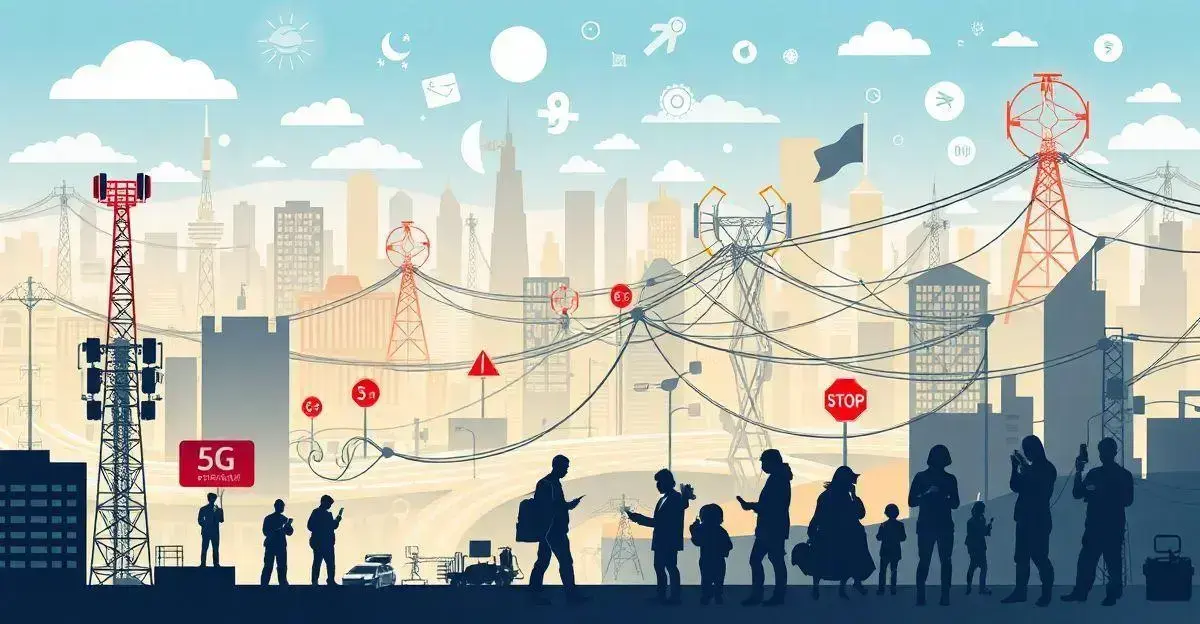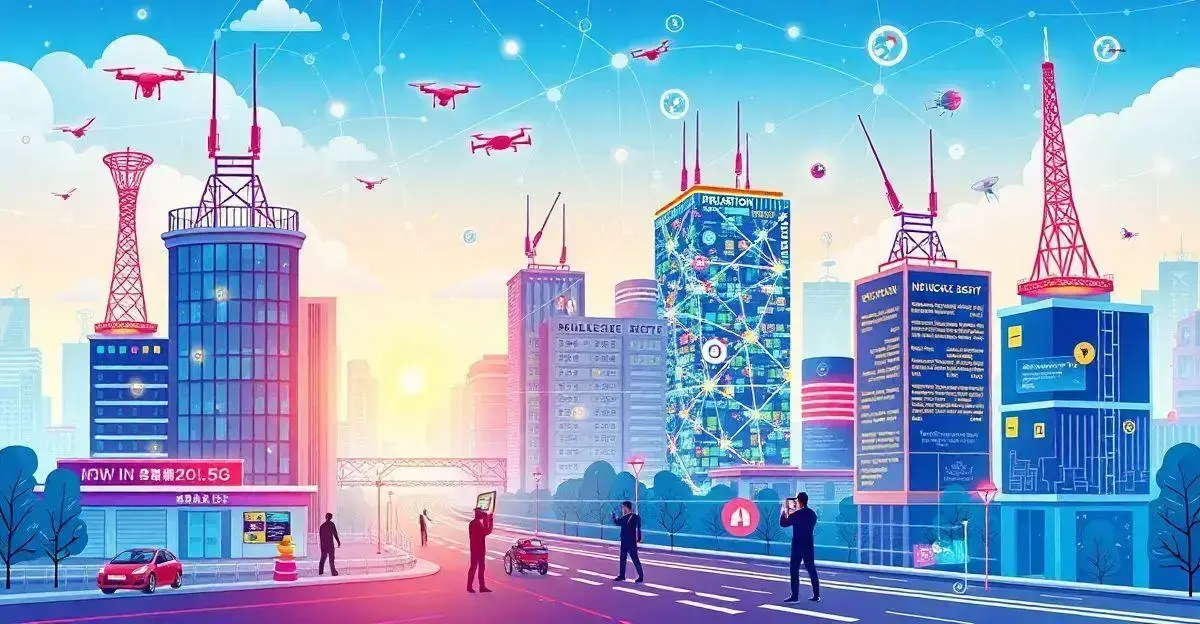5G networks represent a groundbreaking leap in mobile technology. As the world embraces high-speed connectivity, the implications for businesses and consumers alike are profound.
This transformation not only enhances communication but also opens new avenues for innovation and efficiency.
What are 5G Networks?
5G networks represent a major leap in mobile connectivity, delivering speeds and capabilities far beyond previous generations. Unlike 4G, which primarily supports mobile broadband, 5G networks provide a versatile foundation that enables applications extending well beyond smartphones.
This technology offers faster download and upload speeds, significantly lower latency, and the capacity to connect many more devices simultaneously. The core innovation behind 5G is its use of higher-frequency bands, known as millimeter waves, which can transmit vast amounts of data.
However, these frequencies have a shorter range and are more susceptible to physical obstructions, requiring a dense network of small cells positioned closer together than traditional towers.
Moreover, 5G integrates seamlessly across various industries. In smart cities, for example, data from sensors and devices can improve traffic flow and enhance public services. In healthcare, 5G enables groundbreaking possibilities, such as remote surgeries and real-time patient monitoring.
The introduction of 5G networks marks not just an improvement in mobile experiences, but a transformative era of connectivity that will reshape how we live and work.
Benefits of 5G Networks

The benefits of 5G networks are vast, as they promise to enhance connectivity for individuals and industries alike. One of the most significant advantages is the lightning-fast speeds they offer, allowing users to download data almost instantly.
With 5G technology, you can stream high-definition videos without buffering, enabling a seamless viewing experience.
Another critical benefit is the reduction in latency. This means that the response time when sending and receiving data is greatly decreased, which is especially beneficial for applications that require real-time feedback, such as online gaming and virtual reality experiences.
Moreover, 5G networks can connect many more devices simultaneously. This capability is crucial as the number of smart devices in our homes and workplaces continues to grow. With 5G, you can have more devices connected without sacrificing speed or performance.
Industrially, 5G technology supports advanced applications like automation and IoT implementations, enhancing efficiency and productivity. For example, factories can manage machinery remotely with real-time data, leading to better decision-making.
Overall, the potential of 5G networks to drive innovation and improve everyday experiences makes them a vital part of our technological future.
How 5G Networks Improve Connectivity
5G networks significantly improve connectivity through enhanced data transfer rates and reliable connections. With lower latency, users experience minimal delays when accessing online content or services, making everything from video conferencing to online gaming smoother. The speed of 5G networks allows for quick downloads and uploads, which is beneficial for both casual users and professionals working remotely.
Moreover, 5G networks enable better connectivity in densely populated areas. As more devices connect to the internet, the ability of 5G technology to handle simultaneous connections without slowing down is crucial. This improvement is particularly important in urban environments, where users often struggle with slow connections during peak times.
Another aspect of how 5G networks improve connectivity is their support for Internet of Things (IoT) devices. As homes and businesses become smarter, the need for a robust network that can support numerous connected devices becomes essential. With 5G, it is possible to connect thousands of devices without compromising speed.
Furthermore, improved connectivity means that remote areas can access high-speed internet, bridging the digital divide. This ability opens up opportunities for education, telehealth, and e-commerce in regions that previously had limited connectivity.
Challenges in Implementing 5G Networks

Implementing 5G networks comes with various challenges that need to be addressed for successful deployment. One of the primary obstacles is the high cost of infrastructure. Building the necessary network infrastructure, such as small cells and base stations, requires significant investment, which can be a barrier for many companies.
Another challenge is the regulatory hurdles involved in securing the necessary permissions and licenses to set up 5G networks. These regulations may vary by region and can slow down rollout timelines and complicate planning.
Additionally, 5G networks require a larger number of base stations compared to previous generations. This need for more physical sites can lead to difficulties in finding suitable locations, especially in urban areas where space is limited.
Moreover, interference from buildings and natural obstacles can hinder signal strength. Unlike lower frequency bands, which can penetrate obstacles more easily, higher frequency 5G signals are more likely to be affected by such barriers, which is something that needs consideration during the implementation phase.
Lastly, ensuring cybersecurity in the 5G ecosystem is a growing concern. With more connected devices and applications relying on 5G technology, protecting data and networks from potential threats is crucial for maintaining user trust and safety.
Future of 5G Networks
The future of 5G networks looks promising as connectivity continues to evolve. Emerging technologies such as augmented reality (AR), virtual reality (VR), and smart cities will benefit greatly from the expansion of 5G, which enables better data management and real-time communication between devices.
In addition, the rise of smart cities will benefit from 5G, as it allows for better data management and real-time communication between devices.
Furthermore, the integration of 5G networks with the Internet of Things (IoT) will lead to a higher number of connected devices, creating a more interconnected world. This increased connectivity will enhance various industries, from healthcare, where remote patient monitoring will flourish, to agriculture through smart farming techniques.
As we look to the future, the ongoing development and deployment of 5G networks will play a significant role in shaping how we live, work, and interact with technology. Embracing this change can unlock new opportunities and innovations, making it essential to stay informed and prepared for what’s to come.
5G Networks and IoT

The integration of 5G networks with the Internet of Things (IoT) marks a transformative advancement in connectivity, setting the stage for an interconnected and efficient future.
With high-speed data transfer and low latency, 5G technology supports the real-time communication of numerous devices, which enables a broad range of applications across various sectors.
In smart homes, 5G facilitates seamless connections among devices such as smart thermostats, security cameras, and lighting systems. This allows users to control their home environments from anywhere, enhancing convenience and energy efficiency.
In healthcare, 5G empowers remote patient monitoring systems. Real-time data from wearable devices can be sent to doctors, improving patient care and reducing the need for frequent in-person visits.
For smart cities, 5G enables improved infrastructure management through sensor networks that monitor traffic patterns, air quality, and energy usage. This data can lead to optimized resource allocation and more efficient public services.
In agriculture, 5G and IoT support smart farming solutions. Connected devices allow farmers to monitor soil conditions, crop health, and water usage, enabling data-driven decisions that can improve crop yield.
In summary, the convergence of 5G networks and IoT technology will not only enhance individual lives but also drive innovation across industries, paving the way for a more connected and efficient world.
The Future of 5G Networks
As we have explored, 5G networks are transforming the way we connect and interact with technology. With their ability to provide faster speeds, lower latency, and the capacity to support a multitude of devices, 5G technology is paving the way for a new era of connectivity.
These advancements will not only impact individual users but also revolutionise industries, enhancing everything from healthcare to agriculture. The integration of 5G networks with the Internet of Things (IoT) will lead to smarter homes and cities, improving efficiency and quality of life.
While challenges remain, the potential benefits of 5G technology far outweigh the obstacles. Embracing this technology is crucial as we move towards an increasingly connected future.
